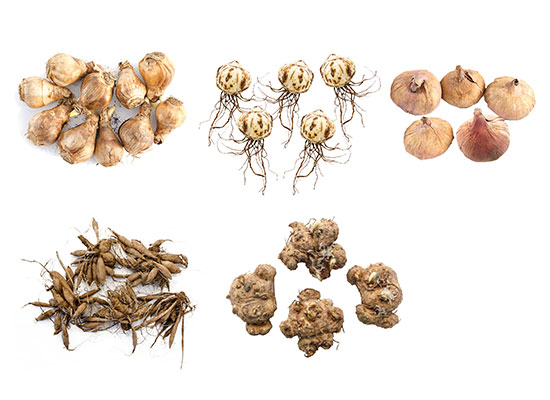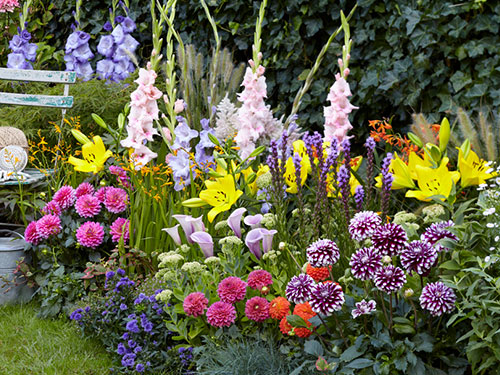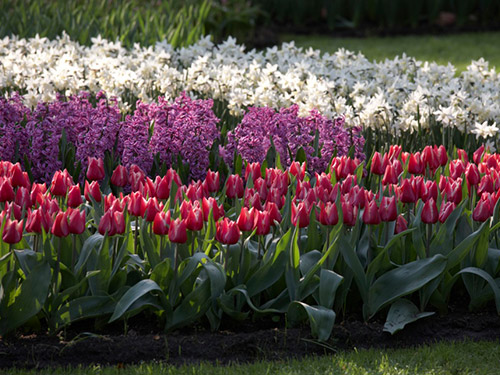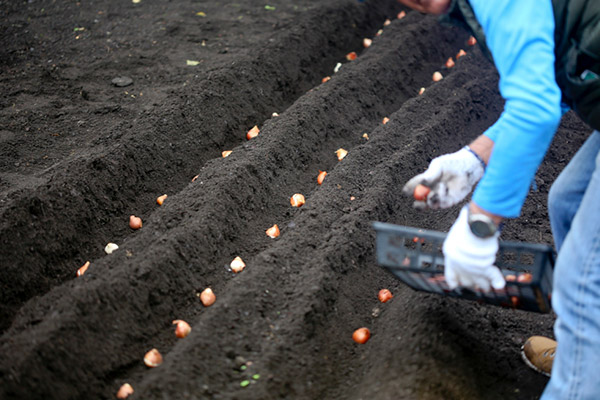Flower bulbs are perfectly contained packages that have what they need to turn into a flower. A true bulb is a thickened, fleshy, and commonly subterranean bud, usually emitting roots from its underside and the stems, flowers, and foliage from the crown. Examples of true bulbs are lilies, tulips and daffodils. The term “bulb” applies to a large class of flowering and ornamental bulbous-like plants in their dormant condition such as corms, tubers, rhizomes and pips.

Because plants emerge from bulbs, bulb size and quality matters. Plump, healthy bulbs help produce robust plants—and you get larger flowers from larger bulbs. If selecting bulbs yourself, avoid bulbs that are mushy or rotten, and select larger, plump flower bulbs.
At K. van Bourgondien, we offer larger-sized, quality bulbs. We also offer one of the best selections of bulbs for spring planting and bulbs for fall planting.
When to Plant Bulbs

Spring-Planted (Summer Blooms)
Tender bulbs, sometimes called summer-blooming bulbs or spring-planted bulbs, can’t tolerate freezing temperatures and are planted in the spring. Some of the most popular tender bulbs are:
- Dahlias
- Cannas
- Calla Lilies
- Gladiolus
- Elephant Ears
Many more tender bulbs are listed on our Bulbs to Plant in Spring page.

Fall-Planted (Spring Blooms)
Hardy bulbs, sometimes called spring-blooming bulbs or fall-planted bulbs, tolerate freezing weather and need a period of cold weather to break dormancy. Some of the most popular hardy bulbs are:
- Tulips
- Daffodils
- Hyacinths
- Crocus
Many more hardy bulbs are listed on our Bulbs to Plant in Fall page.
Where to Plant Bulbs
Flower bulbs are vibrant, versatile additions to any garden design—from formal gardens to naturalized areas, and everything in between. They even do well in containers. Flower bulbs can be planted in large swaths, in small groups among perennials or planted in more natural-looking settings. When planning your garden design with bulbs, keep a few things in mind.
The first rule of thumb is that bulbs must be planted in well-drained soil. If bulbs sit in wet soil that doesn’t drain, they likely will rot.
Most bulbs prefer full or partial sun. Check the light requirements for specific varieties. When planting spring-blooming bulbs, remember that many areas under deciduous trees receive lots of sun in early spring because the trees have not leafed out. Also, low-growing, very early spring bloomers like crocuses can be planted in lawns.
Consider which bulbs to plant and where to plant based upon height, sunlight, color and blooming time. Spacing requirements vary with the bulb size and type. As a general rule, you should be able to fit about two bulbs widths between bulbs. If you’re planting more than a few bulbs, use our Plant Calculator to help determine how many bulbs are needed for a specific area.
How to Plant Bulbs
To get the most out of your bulb display, take time to consider what you want your garden to look like throughout the growing months. Then develop a plan before you order your bulbs and begin planting.
Pre-Planting Considerations
When planning your flower bulb plantings, here are some things to keep in mind:
- Bloomtime. By planting a variety, you can have flowers blooming from early spring through fall. Do you have a particular flower that you love, such as tulips? You can have an extended tulip season if you select a combination of early, mid-season and late-season bloomers.
- Layering plant heights. Selecting a variety of heights and planting the taller plants toward the back allows all flowers to shine—and gives depth and texture to the garden.
- Companion plants (perennial companions). Planting perennials with flower bulbs, especially spring-blooming bulbs, is a great way to add interest to the garden and hide fading bulb foliage.
- Color impact. Planting clusters of one variety gives spaces a pop of color when the flowers burst into bloom. Planting two or three colors can create a dramatic impact. If you’re unsure of what color combinations to plant together, our gardening professionals have designed mixes and blends that complement each other beautifully.
- Size of your space. Map out how many plants you will need for your space or use our Plant Calculator.
- Protection from pests. If deer are a problem, consider incorporating deer-resistant plants in your design. Other gardeners use wire mesh to protect bulbs from squirrels.
Preparing the Soil
Flower bulbs require well-drained soil. You can improve the soil by working in organic matter, such as aged manure, compost or peat moss. We also recommend using Van Bourgondien 100% Natural Bulb Food, a slow-release fertilizer.
How Deep to Plant Bulbs
For fall-planted bulbs the general rule is to plant the bulb about 2-3 times the height of the bulb. For example, if the bulb is 2 inches tall, the planting depth would be 4-6 inches. For spring-planted bulbs, there is more variance, so it’s best to consult the variety’s planting recommendation. If bulbs are planted too deep, they may rot; if they are planted too shallow, they may be exposed to extreme temperature variation.
How to Place the Bulb for Planting
Place bulbs firmly in the soil, pointed end up. Cover the bulbs with soil and water well. Fall planted bulbs in colder climates should be covered with 2-3 inches of mulch.
How to Protect Your Newly Planted Bulbs
Cold temperatures and pests are usually the biggest threats to newly planted bulbs.
For spring-planted tender bulbs, you should protect them from cold temperatures. In southern regions, usually zones 8 and warmer, you can cover them with a layer of mulch. In northern regions, dig them up in the fall and store them in a cool, non-freezing place over winter.
For fall-planted bulbs, gardeners in northern regions often add a few layers of mulch over winter. In southern regions, the bulbs may need to be chilled for several weeks before planting.
Note: do not store in the refrigerator with other fruits and vegetables. Apples, especially, emit a gas that can cause bulbs to rot.
When planting, many gardeners place wire mesh over the plantings to protect the bulbs from squirrels. While many flowers grown from bulbs are deer resistant, some are not. If deer are a problem in your area, consider using a deer repellent or incorporating deer-resistant plants in your garden.
Growing Flower Bulbs
Growing flower bulbs is fairly easy, as long as you follow a few tips.
- As mentioned before, good drainage is essential.
- Do not use strong commercial fertilizer or fresh manure when planting. Van Bourgondien 100% Natural Bulb Food is a slow-release fertilizer formulated specifically for bulbs.
- When cutting flowers from your bulbous plants, cut as little foliage as possible. The leaves are essential for storing next year’s food.
- Deadhead spent tulip flowers immediately after flowering, as the bulbs’ vigor declines if seed pods are allowed to develop.
- Always let the foliage die back on its own in the garden before trimming it back or digging up the bulbs.
- Never dry bulbs in the sun. Always dry bulbs in the shade in a well-ventilated area.
- Always store bulbs in a dry, well-ventilated area to prevent mold or mildew. Do not store them in an air-tight container.
- When your bulbs are in the bud, bloom and early foliage stage, make sure they receive about 1 inch of water weekly.
- Watering your bulbs well after planting will prevent air pockets.
For more tips and care instructions on growing individual flower varieties, visit KVB’s blog.

